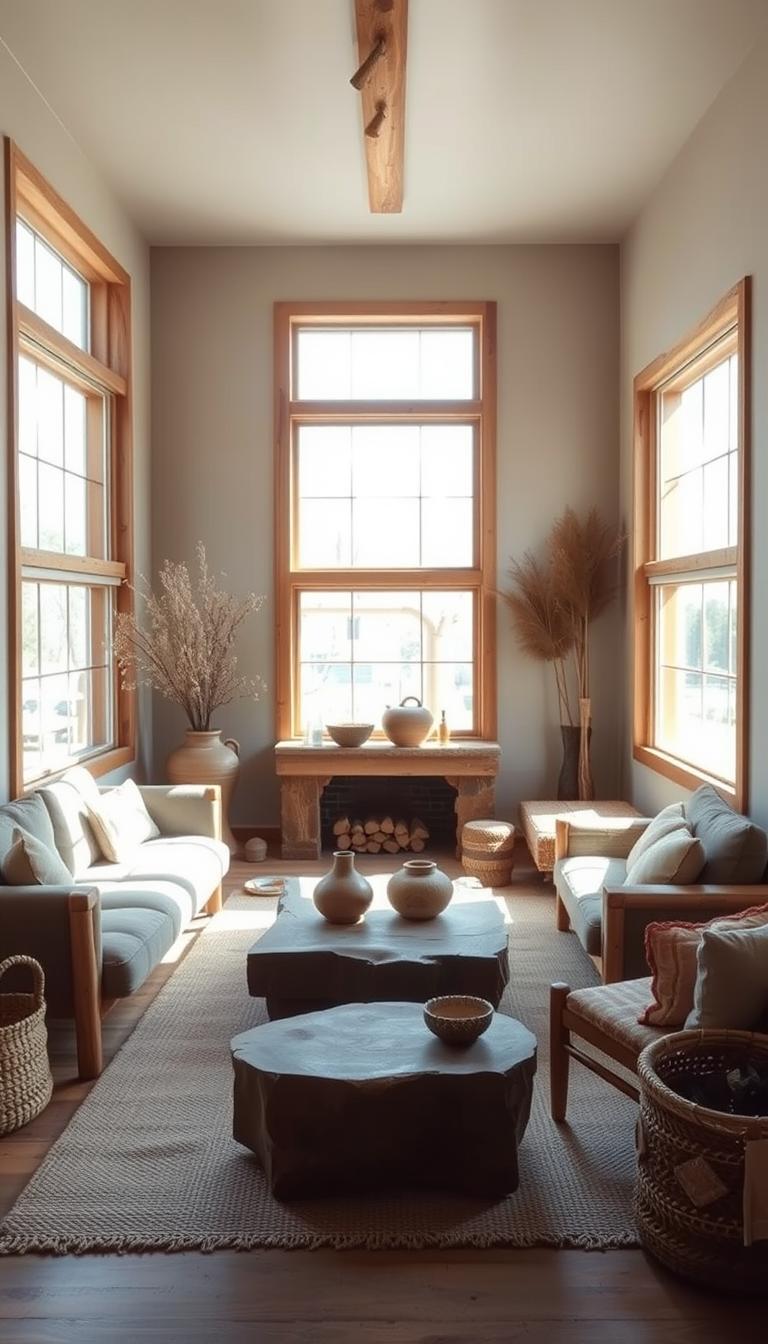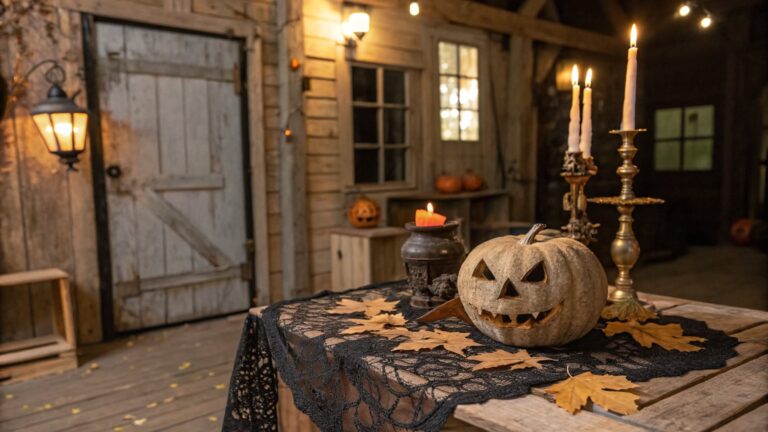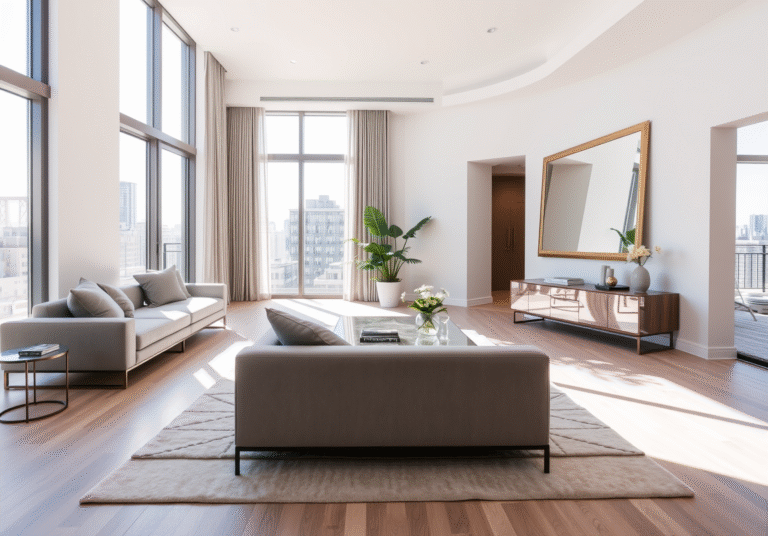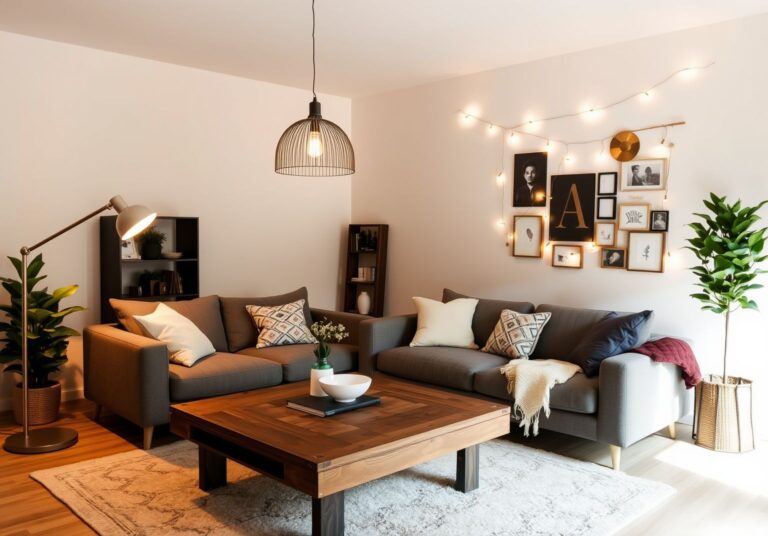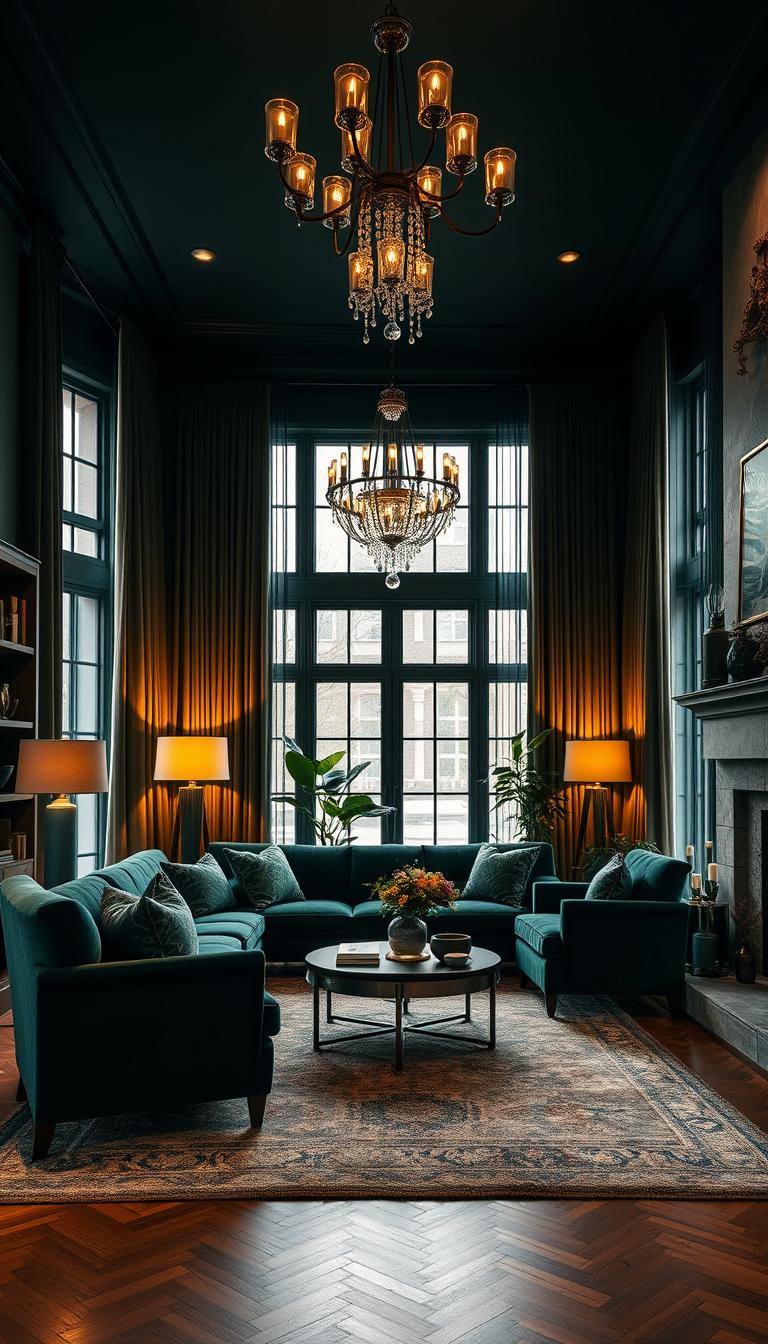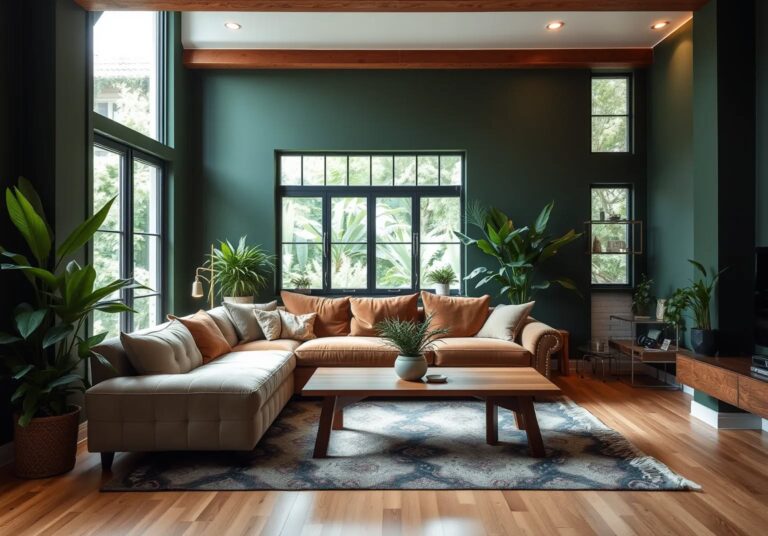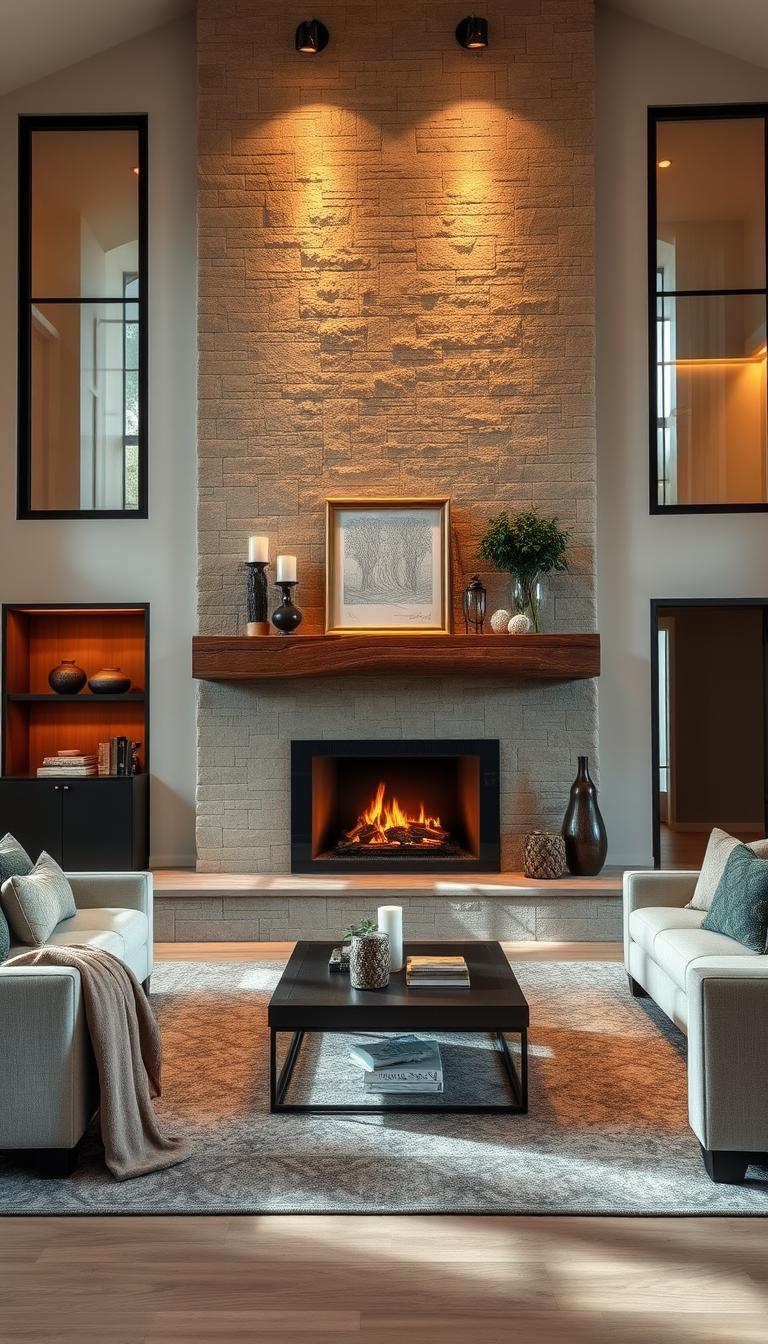Transform Your Space with Wabi Sabi Living Room Style
Wabi Sabi is more than just an interior design trend; it’s a philosophy that celebrates the beauty of imperfection and impermanence. Rooted in Japanese culture, it appreciates the transience in nature, reflected in its aesthetic of serenity in simplicity.
Unlike conventional design approaches that hide imperfections, Wabi Sabi living room design embraces them, creating a unique atmosphere that promotes mindfulness. This style is gaining popularity in Western interior design as people seek more authentic and calming space.
By adopting Wabi Sabi principles, you can create a more peaceful environment and a deeper connection to your living room. The following guide will walk you through every aspect of transforming your space into a serene Wabi Sabi haven, highlighting the beauty in everyday objects.
Understanding the Wabi Sabi Philosophy
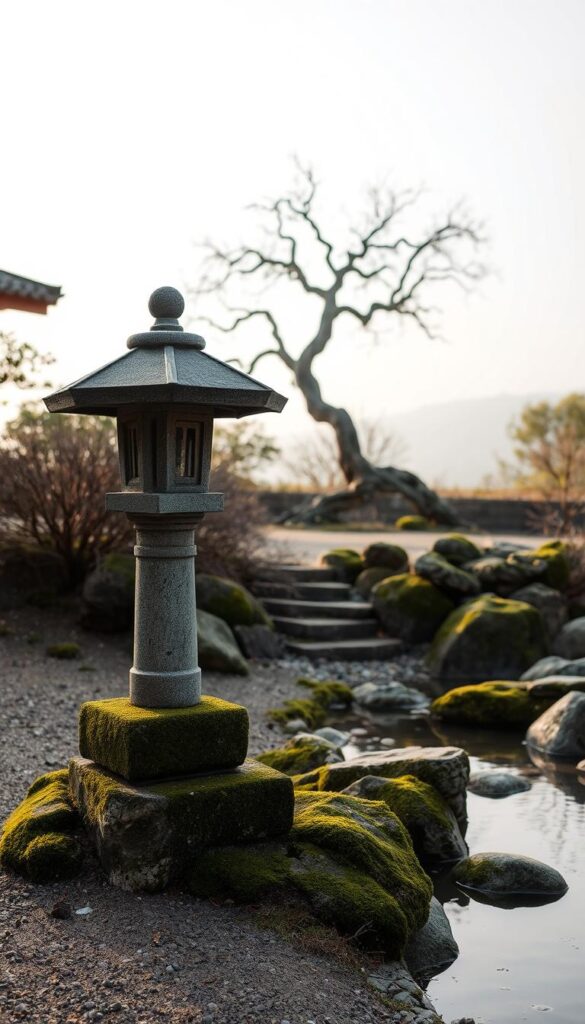
Wabi Sabi, a profound Japanese philosophy, finds beauty in the impermanent and imperfect nature of life. Originating from tea ceremonies in 16th-century Japan, this worldview emphasizes simplicity and natural materials.
The term “Wabi Sabi” is derived from two Japanese terms: “wabi,” meaning rustic simplicity or freshness, and “sabi,” referring to the beauty that comes with age and imperfection. Together, they form a philosophy that celebrates the impermanent nature of life.
- The historical roots of Wabi Sabi in Japanese tea ceremonies and its evolution into a broader worldview.
- The linguistic origins of “wabi” and “sabi” and their combined meaning.
- Wabi Sabi’s embrace of life’s impermanence and finding beauty in growth, decay, and imperfection.
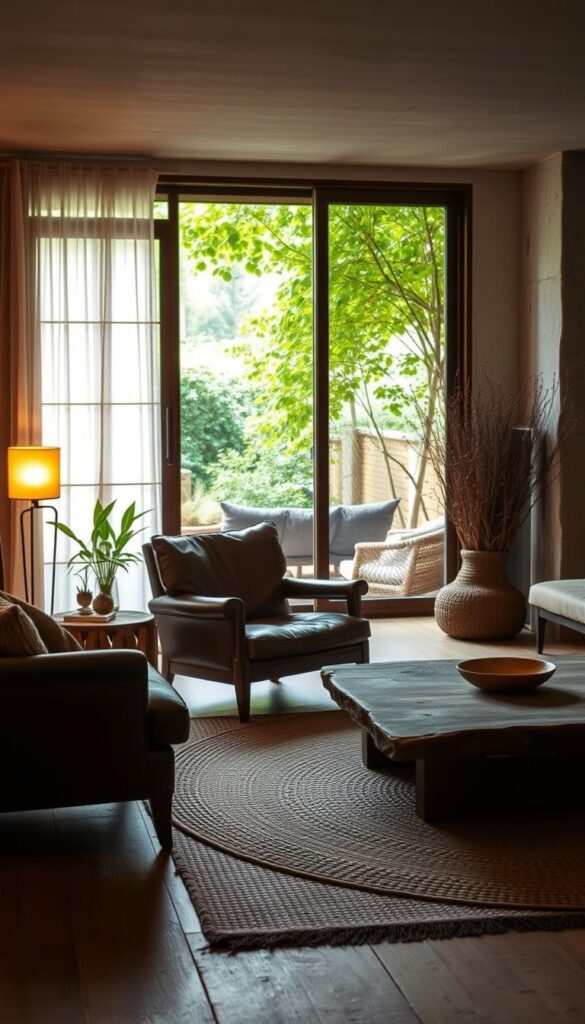
This Japanese philosophy contrasts with Western ideals of perfection, offering a unique perspective on beauty and aesthetics that has influenced various aspects of culture, from art to mindfulness practices.
Core Principles of Wabi Sabi Design
Embracing imperfection and impermanence, Wabi Sabi design offers a unique approach to interior design. At its core, Wabi Sabi is about creating a calm environment that celebrates the natural world.
The use of natural materials is a fundamental element of Wabi Sabi design, emphasizing the beauty of nature. Materials such as wood, stone, and clay are preferred for their earthy texture and natural appearance. This focus on natural materials connects the interior space to the natural world, creating a sense of authenticity.
- Wabi Sabi design celebrates the beauty of imperfection, where cracks, wear, and asymmetry are valued rather than hidden.
- Simplicity and minimalism are key, focusing on the concept of “less is more” and eliminating unnecessary elements to create a serene atmosphere.
- The concept of “ma” or negative space is crucial, as it creates balance and tranquility in a living room by providing visual breathing room.
Wabi Sabi also emphasizes authenticity through the use of handcrafted items and objects with history and character. The principle of impermanence influences design choices, accepting that materials will age and change over time, adding to their beauty.
By combining these principles, Wabi Sabi design creates spaces that are both grounded and elevated, simple yet sophisticated, reflecting a deep appreciation for the natural world and the passage of time.
Creating a Wabi Sabi Living Room: The Essentials
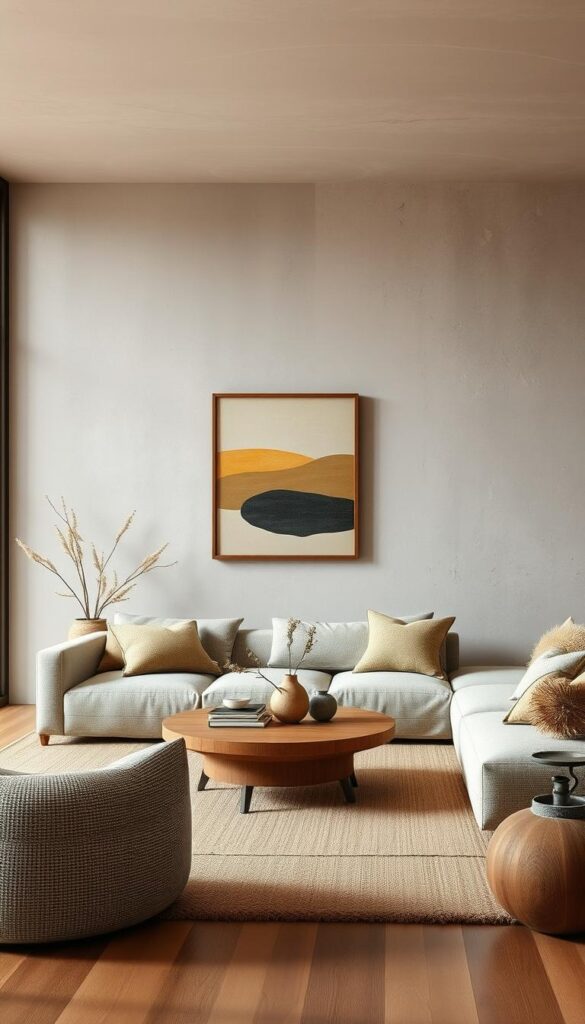
Embracing the Wabi Sabi style in your living room involves more than just decoration; it’s about crafting a serene and authentic environment. To start, decluttering your space is essential, creating a clean slate that allows the true character of your room to shine.
Assessing your existing interior design elements is crucial. Identify pieces that can be incorporated into your new Wabi Sabi aesthetic, and consider replacing those that don’t fit. Simple, unadorned furniture and natural textiles can greatly contribute to the desired ambiance.
A balanced layout is key to a functional and aesthetically pleasing room. Consider the flow of natural light and how it interacts with different materials throughout the day. The concept of “curated imperfection” is central to Wabi Sabi, where each element is chosen with intention, despite or because of its imperfections.
By thoughtfully selecting elements and embracing the unique character of your space, you can create a Wabi Sabi living room that feels both authentic and intentional.
Choosing the Right Color Palette
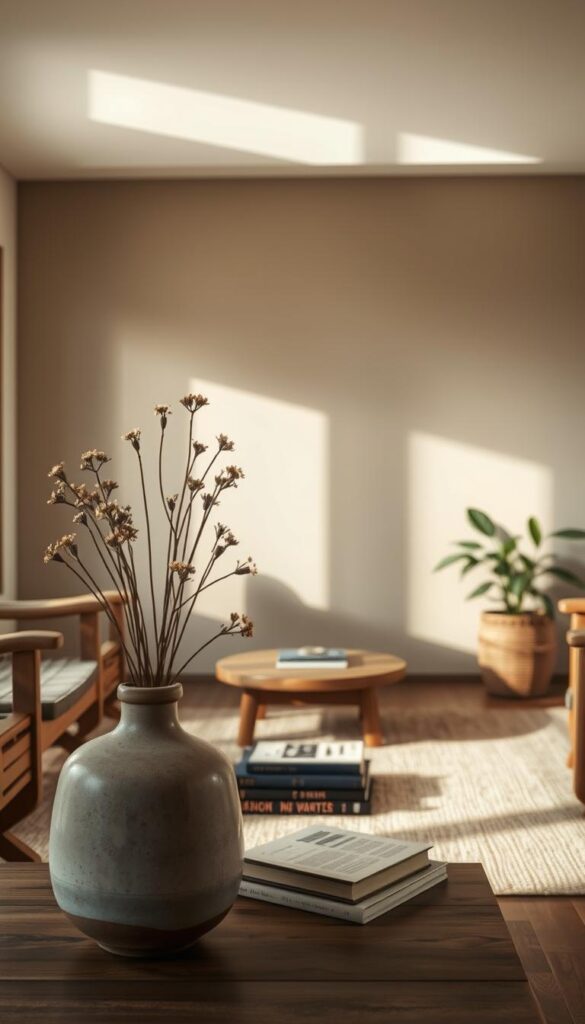
Embracing the Wabi Sabi aesthetic begins with selecting a color palette that resonates with nature’s subtlety. The characteristic color palette of Wabi Sabi design focuses on earthy, muted tones that evoke a sense of connection to nature and create a calming atmosphere.
To create a Wabi Sabi living room, start by selecting base colors for walls, floors, and large furniture pieces. Shades like sandy brown, gray, burnt orange, and saturated green are typical. Dark neutrals, white, and black also feature often in Wabi Sabi interiors, setting a calming and harmonious tone.
- Select base colors that will serve as the foundation for your Wabi Sabi living room.
- Use contrast strategically through the incorporation of darker elements.
- Incorporate subtle color variations to add depth and interest.
Natural materials bring their own inherent colors to the space. Working with these elements rather than against them is key to a harmonious Wabi Sabi design. The color palette subtly transforms with natural light throughout the day, creating a living space that evolves from morning to evening.
| Color | Tone | Effect |
|---|---|---|
| Sandy Brown | Warm | Cozy |
| Gray | Neutral | Balancing |
| Burnt Orange | Warm | Inviting |
Before committing to specific colors, test them in your unique lighting conditions to ensure they create the desired atmosphere.
Natural Materials for Your Wabi Sabi Living Room
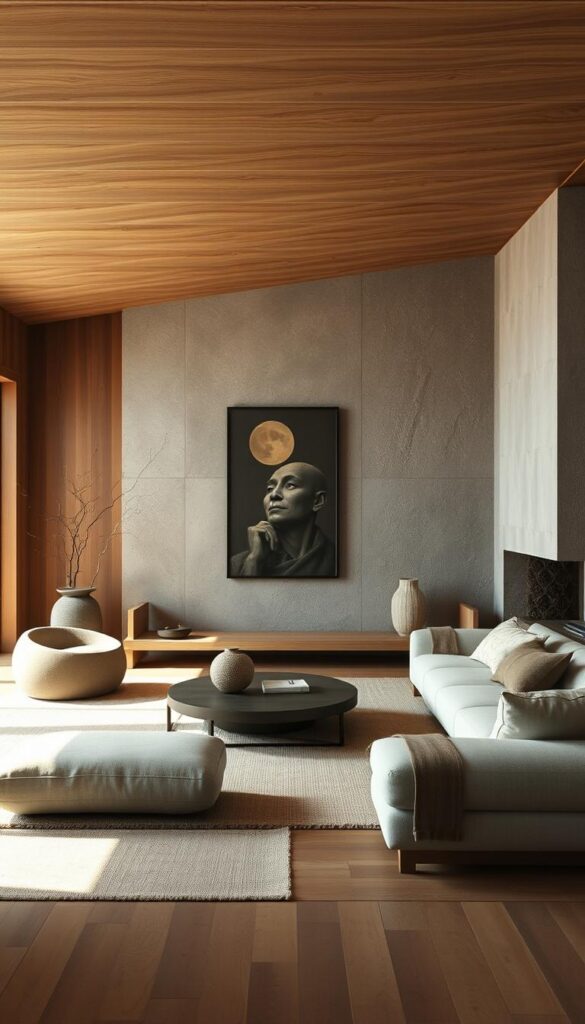
The essence of Wabi Sabi lies in its use of natural materials that tell a story through their textures and imperfections. Wabi Sabi design relies heavily on raw materials that bring warmth and authenticity to a space.
Essential natural materials include untreated wood, raw stone, clay, and textured textiles like jute, linen, and wool. These materials are prized for their unique textures and histories, which age gracefully over time.
When selecting natural materials, it’s crucial to identify quality pieces that will develop a beautiful patina. Material authenticity is key; avoid synthetic imitations that lack the character of genuine materials.
Combining different natural materials can create a rich textural interest. For example, pairing reclaimed wood flooring with natural stone accent pieces and linen textiles can add depth to your Wabi Sabi living room.
The inherent imperfections in natural materials are a hallmark of Wabi Sabi design. Proper care and maintenance of these materials will ensure they age beautifully, enhancing the overall aesthetic of your space.
Furniture Selection for Wabi Sabi Style
The essence of Wabi Sabi living room design lies in the careful selection of furniture that highlights natural materials and understated elegance. For a Wabi Sabi living room, it’s crucial to opt for furniture with clean lines and minimal ornamentation, allowing the natural beauty of the materials to take center stage.
When selecting furniture pieces, consider the importance of natural materials such as wood and linen. A wooden coffee table with a natural edge can add character to the room, while linen upholstery can bring in a sense of simplicity and elegance.
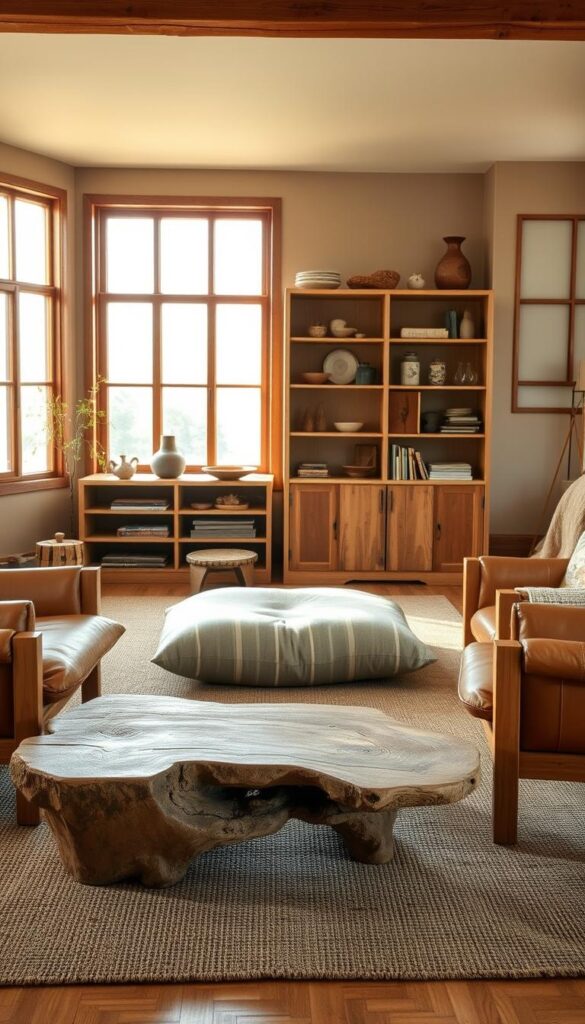
| Furniture Piece | Material | Wabi Sabi Characteristic |
|---|---|---|
| Coffee Table | Reclaimed Wood | Natural Edge, Imperfections |
| Sofa | Linen Upholstery | Simple Design, Neutral Color |
| Storage Unit | Solid Wood | Minimalist Design, Handcrafted |
By choosing furniture that embodies these principles, you can create a Wabi Sabi living room that is both serene and authentic.
Textural Elements and Layering
Wabi Sabi living rooms are characterized by their rich sensory experience, achieved through the thoughtful use of various textures and materials.
To create depth and interest in your Wabi Sabi living room, it’s essential to incorporate a variety of textures. Natural textures like linen curtains, sisal rugs, woolen throw pillows, and bamboo blinds not only add visual appeal but also create a tactile experience.
- Layer different textural elements, from rough to smooth, to create a rich sensory experience.
- Incorporate specific textural elements such as hand-woven textiles, rough pottery, and raw wood.
- Balance different textures to create harmony and avoid visual chaos.
By thoughtfully layering textures and elements, you can create a Wabi Sabi living room that feels authentic and inviting, giving you a sense of connection to the natural world.
Lighting in a Wabi Sabi Living Room
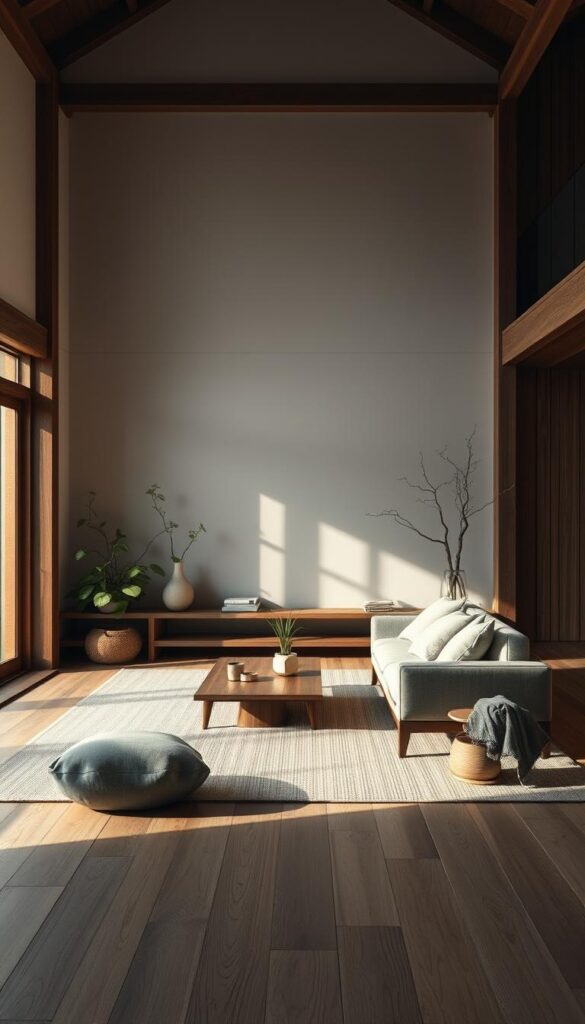
Soft, diffused lighting is key to crafting a Wabi Sabi living room that exudes warmth and serenity. In a Wabi Sabi room, the emphasis is on creating a calm atmosphere that feels both natural and inviting.
Thoughtful lighting plays a central role in achieving this ambiance. Natural light is maximized through window treatments that filter rather than block light, contributing to the serene feel of the space.
The selection of light fixtures complements Wabi Sabi aesthetics, focusing on natural materials and simple forms. Layers of lighting, including ambient, task, and accent lighting, maintain the calm atmosphere while ensuring the room remains functional.
In a Wabi Sabi interior, shadows and light patterns create dynamic elements, adding to the room’s sense of character. Warm-toned lighting enhances natural elements, contributing to the cozy feel of the living room.
Bringing Nature Indoors
To truly embody the Wabi Sabi aesthetic, it’s essential to introduce natural elements into your living room. Adding one or two potted plants can invigorate the look, but varying their heights creates a more dynamic display. For instance, pairing an oversized indoor plant with a moisture-loving mini fern in organic pots adds a special touch.
The natural world inspired the concept of Wabi Sabi, making it a must to incorporate natural items such as houseplants, organic fabrics, stone, and wood. Selecting plants with interesting textures, organic forms, and subtle beauty complements the Wabi Sabi aesthetic. Beyond plants, elements like driftwood, stones, and dried branches bring the outside world into your living space.
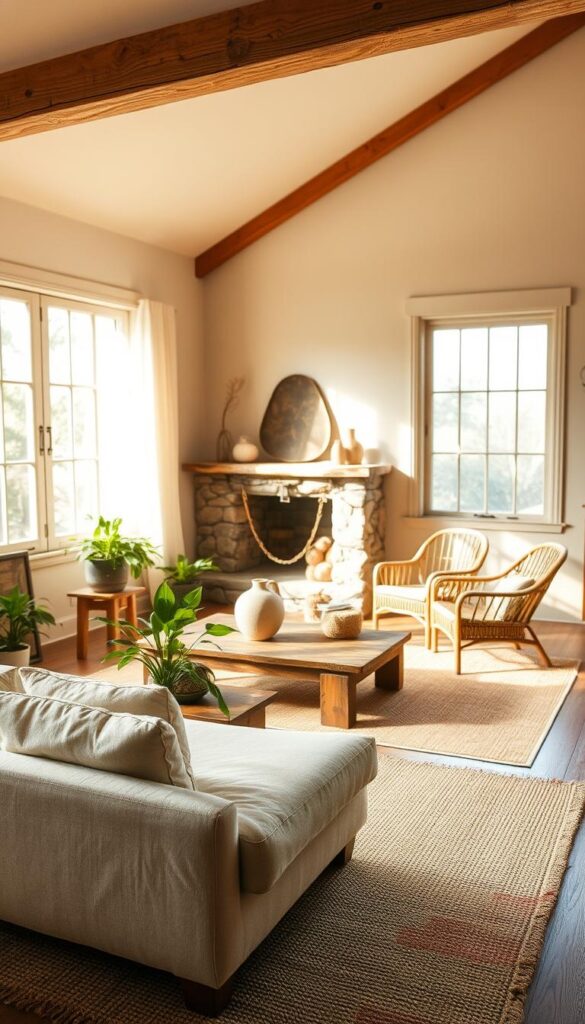
Displaying nature-inspired elements in a way that highlights their inherent beauty while maintaining the minimalist approach of Wabi Sabi design is key. Rotating natural elements seasonally acknowledges the passage of time and adds another dimension to the Wabi Sabi living experience. By doing so, you not only enhance the authenticity of your living space but also contribute to improved well-being through biophilic connections.
Common Mistakes to Avoid in Wabi Sabi Design
Achieving a genuine Wabi Sabi style requires avoiding several common mistakes that can make a space feel inauthentic. Wabi Sabi celebrates the beauty of imperfection, embracing cracks, chips, and weathering as marks of character.
One common misconception is that Wabi Sabi is about displaying broken items. Instead, it’s about curating imperfections that tell a story. Artificially distressing items can also contradict Wabi Sabi’s authentic nature.
- Confusing Wabi Sabi with cluttered spaces; true Wabi Sabi requires intentionality and restraint.
- Creating a themed “Japanese” room instead of embracing universal Wabi Sabi principles.
- Focusing solely on aesthetics without understanding Wabi Sabi’s philosophical underpinnings.
- Neglecting functionality in pursuit of beauty; Wabi Sabi balances form and function.
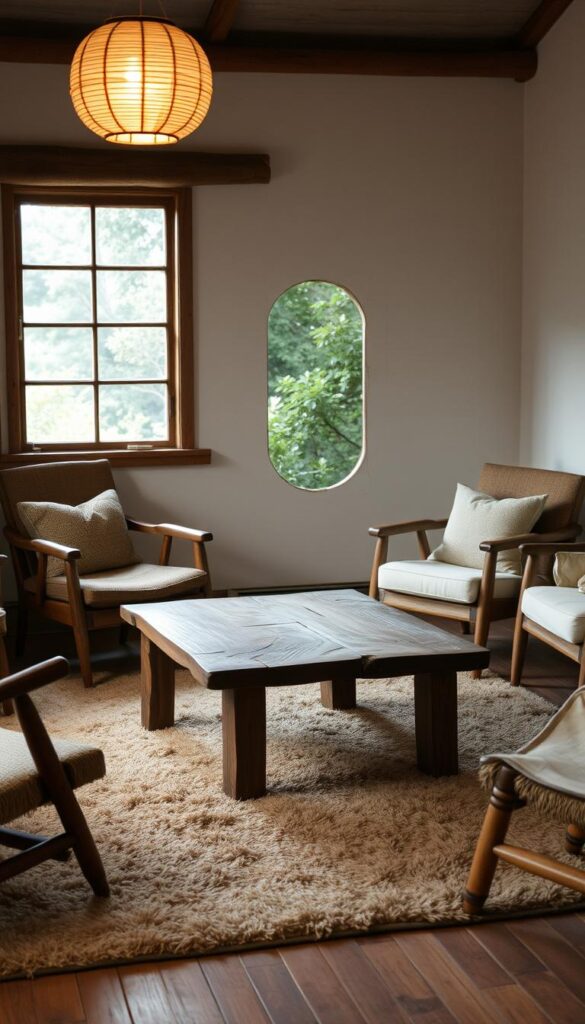
By avoiding these mistakes, you can create a more authentic Wabi Sabi living room that embodies elegance and beauty.
Conclusion: Embracing Imperfection in Your Living Space
By adopting Wabi Sabi, you’re not just decorating your home, you’re cultivating a mindset that values simplicity and beauty in imperfection. This approach transforms your living room into a serene space that reflects your personal sense of harmony.
